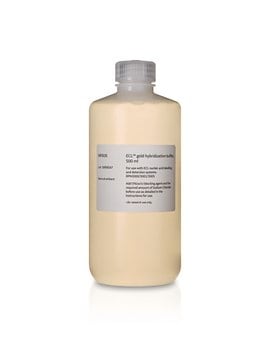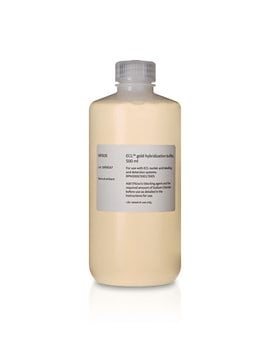GERPN3005
ECL™ Direct Nucleic Acid
Cytiva RPN3005, pack of 1 ea
Sign Into View Organizational & Contract Pricing
All Photos(1)
About This Item
UNSPSC Code:
41105300
NACRES:
NA.31
Recommended Products
packaging
pack of 1 ea
manufacturer/tradename
Cytiva RPN3005
storage temp.
2-8°C
Related Categories
General description
ECL™ Direct Labeling Module.
Application
ECL™ Direct Nucleic Acid Labeling and Detection Systems are based on the direct labeling of DNA or RNA probes with horseradish peroxidase (HRP) in a simple 20 min chemical reaction. The resulting probe can be used without purification. Detection is achieved by generation of light via the HRP-catalyzed breakdown of luminol.
Each system includes the following reagents, sufficient for labeling 5 to 10 μg nucleic acid and detecting 2000 to 4000 cm2 of membrane (depending on product ordered): labeling reagent, crosslinker, control DNA, blocking agent, ECL™ Detection Reagents, and ECL™ Gold Hybridization Buffer.
Each system includes the following reagents, sufficient for labeling 5 to 10 μg nucleic acid and detecting 2000 to 4000 cm2 of membrane (depending on product ordered): labeling reagent, crosslinker, control DNA, blocking agent, ECL™ Detection Reagents, and ECL™ Gold Hybridization Buffer.
Storage and Stability
Please be aware this product may be shipped 90 days before the expiration date. For more information on the batch specific expiration date, please contact technical service.
Analysis Note
To view the Certificate of Analysis for this product, please visit www.cytiva.com.
Legal Information
ECL is a trademark of Cytiva
related product
Product No.
Description
Pricing
Signal Word
Danger
Hazard Statements
Precautionary Statements
Storage Class Code
12 - Non Combustible Liquids
Choose from one of the most recent versions:
Certificates of Analysis (COA)
Lot/Batch Number
It looks like we've run into a problem, but you can still download Certificates of Analysis from our Documents section.
If you need assistance, please contact Customer Support.
Already Own This Product?
Find documentation for the products that you have recently purchased in the Document Library.
C Martins et al.
Genome, 44(5), 903-910 (2001-10-30)
To address understanding the organization of the 5S rRNA multigene family in the fish genome, the nucleotide sequence and organization array of 5S rDNA were investigated in the genus Leporinus, a representative freshwater fish group of South American fauna. PCR
Yasuko Kimura et al.
Yeast (Chichester, England), 19(16), 1437-1445 (2002-12-13)
We recently discovered, on the chromosome of Saccharomyces cerevisiae sigma 1278b, novel MPR1 and MPR2 genes required for resistance to a toxic analogue of L-proline, L-azetidine-2-carboxylic acid. The MPR genes, which were absent in the S. cerevisiae genome project strain
Shin-Ichi Miyata et al.
Microbiology (Reading, England), 149(Pt 8), 2243-2250 (2003-08-09)
Thymidylate kinase (TMK) catalyses the phosphorylation of dTMP to form dTDP in both the de novo and salvage pathways of dTTP synthesis in both prokaryotes and eukaryotes. Two homologues of bacterial thymidylate kinase genes were identified in a genomic library
Detection of the antiseptic- and disinfectant-resistance genes qacA, qacB, and qacC in methicillin-resistant Staphylococcus aureus isolated in a Tokyo hospital.
Jun-ichiro Sekiguchi et al.
Japanese journal of infectious diseases, 57(6), 288-291 (2004-12-30)
G Y Akita et al.
Journal of veterinary diagnostic investigation : official publication of the American Association of Veterinary Laboratory Diagnosticians, Inc, 5(2), 154-158 (1993-04-01)
A previously described bluetongue virus (BTV) serogroup polymerase chain reaction (PCR) assay was applied to clinical samples. The sensitivity of the BTV serogroup PCR was increased by the use of non-radioactive chemiluminescent hybridization. Unfractionated whole blood samples from rams experimentally
Articles
Background and protocols describing the various methods used by molecular biologists to detect samples of protein or nucleic acids bound to membranes.
Our team of scientists has experience in all areas of research including Life Science, Material Science, Chemical Synthesis, Chromatography, Analytical and many others.
Contact Technical Service








